Combat aircraft. Insolent, fast, useless
Yes, let's start with the dead end sign. Really Me.163 was a dead end branch of development aviation, despite its rather interesting characteristics. It can even be called the forerunner of many aircraft, and not even atmospheric, which used the missile principle inherent in the design, which was laid down by Tsiolkovsky.
But let's not rush to conclusions (they will be, as always, at the end), but let’s think about this. The "Comet", and this is what this aircraft was called (is it an aircraft?) In Germany, there were many nominations: "first", "only", "unique".
Me.163 - the only one in stories World War II tailless aircraft, equipped with a liquid rocket engine, adopted for service and participated in the battles. Plus, he retained the title of the fastest aircraft.
Well, the most piquant - with no car and no designer in Germany at that time they did not treat them as in this case. Few people know, but Willy Messerschmitt had nothing to do with Comet.
The plane was created by Alexander Lippisch from DFS.
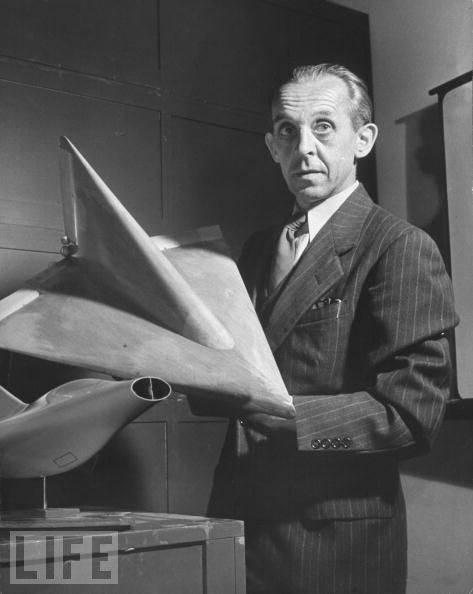
In general, initially his group created and created the DFS-194 motor glider with a Walter rocket engine with a thrust of 400 kg.

The glider made its first flight in 1940 and demonstrated good flight performance, showing a speed of 545 km / h.
Remembering the experienced Lippisch glider, the German Ministry of Aviation ordered him to remake the DFS-194 under a more powerful engine, and a group of designers was transferred to the company Messerschmitt. And when the modernized glider began to undergo the first flight tests in tow at Bf.110 and pass them successfully, it was given the name Me.163.
You can also co-sponsor Professor Lippisch with Dr. Boimker, the head of the test department of the Ministry of Aviation of the Reich and his deputy Dr. Lorenz. Two of these worthy gentlemen in every possible way promoted the idea of a rocket engine on an airplane, and it was Lorentz who came up with the scheme of the apparatus without tail empennage to reduce the influence of a jet stream on the controls.
Willy Messerschmitt ... Well, it so happened that when the plane flew, Willy gave his colleague Alexander such a merry life that Lippisch chose to go to Austria. On the other hand, it’s hard to say if they could launch missile fighter jets in small DFS facilities to the volumes that the Ministry of Aviation saw.
A short digression back, just a couple of years, in 1939, when the world's first rocket plane made its first flight. It was Heinkel’s creation, Heinkel He.176. Yes, then the real flight on the Walter’s engine lasted only 50 seconds, and the device accelerated to 350 km / h.
Then the first conclusions were made about the voracity of rocket planes and a short flight time. And interest in rocket aircraft in the Reich has fallen significantly. So far, two fans of rocket engines, Boymkel and Lorenz, have not appeared in the Ministry of Aviation.
And work began on turning the DFS-194 glider into an airplane. The design of the airframe made it possible to install a conventional piston motor with a thrusting screw in the rear part to finally fly around the airframe and then change it to Walter's liquid propellant rocket engine.
At the beginning of 1940, the glider was delivered to a very interesting place: the Peenemuende-Karlshagen research center, where the Fau-1 projectiles were tested. There, together with specialists from the center, work began on debugging engines.
Walther RI-203 liquid propellant rocket engine, the same as on He.176, only adjusted for less thrust, about 300 kg. This allowed to reach a working time of 150 s. In the summer of 1940, motor flights were performed, which showed that the aircraft has good stability and controllability. The main advantage was a significant rate of climb - a quality that is very important for the future interceptor. The horizontal speed reached 550 km / h.
The Ministry of Aviation has begun to look more favorably at new technology.
Meanwhile, the pre-production aircraft Lippisch P01, V1, V2, V3 were renamed Me.163. This was due to the requirements of secrecy and counteraction to foreign intelligence. The fact is that the name Bf.163 was already reserved for a light multi-purpose aircraft, everyone attributed Lippish to DFS, in general, everything was very realistically confused.
By the summer of 1941, five prototypes were built, of which two (V4 and V5) were transported to Peenemuende, where they were equipped with RP-203b engines with step-controlled traction from 1,48 kN (150 kgf) to 7,38 kN (750 kgf). Fuel tanks contained 1200 kg of fuel and oxidizer, which was enough for 2,25 minutes of flight with full thrust.
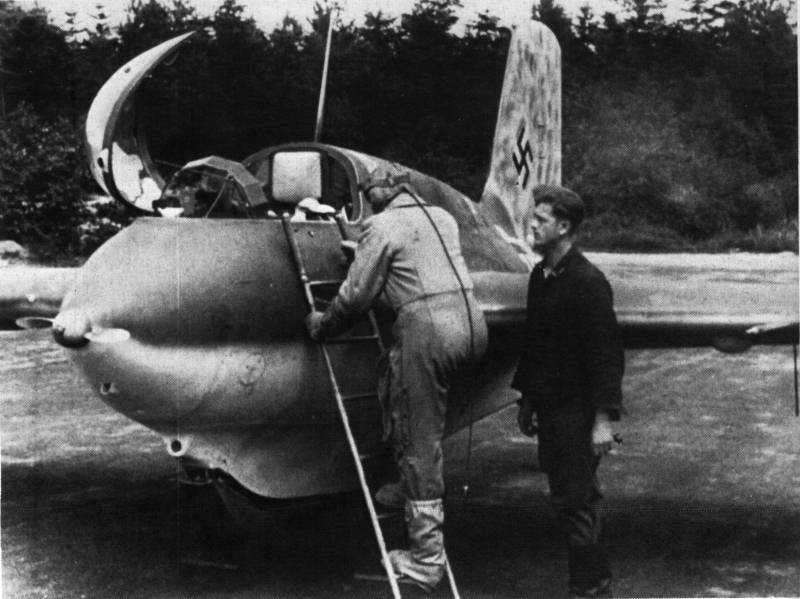
The first motor take-off was performed on August 10, 1941. And already in the first flights, on August 13, the speed of 800 km / h was exceeded, which exceeded the official world speed record at that time.
When starting from the ground, the aircraft showed a very decent speed of 920 km / h. The flight lasted about 4 minutes. Engineers understood that speed could be higher, because on October 2, 1941, the following experiment was completed: Bf.110 lifted a fully refueling aircraft in tow to an altitude of 4 meters, pilot Dittmar started the engine and began acceleration.
The aircraft accelerated to 1003,67 km / h. At the same time, the plane began to vibrate and lower its nose, passing into a dive. This forced Dittmar to turn off the engine, and after braking, aircraft control was restored. The pilot landed the plane, but the skin was very deformed.
This incident entailed a thorough alteration of the wing. Now it was made with constant sweep of the leading edge - 26 degrees. To prevent flow stall at the wing ends, fixed slats were installed on the leading edge. This was a very good decision, the resistance grew slightly, but the plane became impossible to drive into a tailspin.
In general, a good wing was the key to the success of this aircraft. Now, after so many years, we know that for high subsonic speeds of 800-900 km / h, wings with a sweep of 25-30 degrees work best. And in 1939, Lippis, of course, did not know this, but intuitively hit the spot by designing the optimal wing for his plane.
Therefore, Me.163 had perfect balancing, did not break into a tailspin, its aerodynamic focus did not shift. In general, it turned out to be an extremely stable aircraft, and besides, it was not yet exposed to a wave crisis when transonic speeds were reached.
You can talk about incredible luck, you can talk about incredible talent of the designer, I think the truth is hanging somewhere in the middle, as usual.
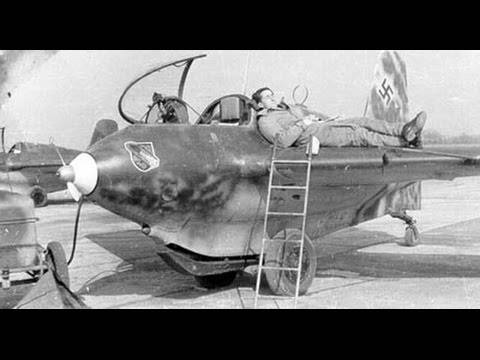
In general, the people were quite objective in the ministry, and they wanted to use the Li.163S letters to designate a production aircraft, but Lippisch had already packed his bags, going to Austria, and why upset Uncle Willy, who would have to let out his own foreign plane in their factories? Anyway, in the undercover fight Messerschmitt was that tank. Not a tank that is from Focke-Wulf, but just a tank. With caterpillars and a gun.
And so Lippisch remained the Messerschmitt plane.
In fairness, it is worth noting that the prototype Me.163A and serial Me.163V were similar in appearance, but very structurally different.
For the production version, Walter prepared a new engine, R P-211 VI (HWK 109-509A). The engine had an adjustable thrust in the range from 0,98 kN (100 kgf) to 1,47 kN (1500 kgf). With maximum thrust, Walter promised fuel consumption of the order of 2,5-3 kg / s.
Based on this, Lippisch designed the aircraft for 12 minutes of motor flight: 3 minutes at full throttle - take-off and climb and 9 minutes at reduced thrust - attack and cruise flight.
But Walter did not manage to withstand the declared consumption, and the fuel consumption was much larger. This gave rise to many further difficulties in both the completion and operation of the aircraft.
That is, much more fuel was needed than originally planned. To do this, I had to take very dramatic steps. After all, it was necessary not only to provide the engine with fuel, but also to maintain normal alignment as fuel was developed.
The main tank with an oxidizing agent of 1040 liters was placed behind the cockpit, in the region of the center of gravity. Two more oxidizer tanks of 60 liters were actually in the cockpit, on the sides. Doubtful neighborhood, don't you find? Nitric acid, concentrated to 85% hydrogen peroxide, nitrogen tetroxide ...
The tanks were protected, but this did not help with strong shocks. After the case of a hard landing of one of the first aircraft, when the tank cracked from the impact and the undeveloped oxidizer actually dissolved the pilot alive, the tanks were removed.
The entire fuel supply (С-stoff) was placed in the wings, distributing the fuel in terms of wingspan, and not along the length of the aircraft, which also helped to maintain alignment while consuming components.
Each wing had a 73 liter tank in front of the side member, and 177 liter after the side member. Since the fuel components were hazardous aggressive fluids, tanks made of special materials were needed for their storage. Pure aluminum was best suited for hydrogen peroxide (tanks were made of it), and glass for fuel. But it is difficult to make a tank out of glass, therefore, steel enameled tanks with a glass coating were used. Corresponding pipelines were made using the same technology.
An interesting solution was the nose cone, which was cast from armored steel. The cone had a thickness of 15 millimeters and protected not only the pilot, but also the blocks of equipment that were placed under his protection.
The cockpit was simply huge for such a small device.
The lantern was also a novelty, Me.163 became the first aircraft with an unbranded lantern. Later, all countries copied this, especially when durable materials appeared that made it possible to make flashlights without optical distortion. As a modification, a small window was made in the lantern for ventilation, because the vapor of hydrogen peroxide or nitric acid inevitably penetrated into the cockpit did not affect the olfactory organs and vision of the pilots in the best way.
The pilots' protection consisted of 90 mm bulletproof glass and three armor plates covering the head (13 mm), back (13 mm) and shoulders (8 mm). The rear wall of the cockpit was fireproof, and the pilot's seat was attached to it on shock absorbers.
The cabin was leaky with all the ensuing consequences. On the one hand, there was some kind of ventilation, on the other hand, a quick climb on a fighter of a new formation required good physical shape from the pilots due to large pressure drops.
The tail of the fuselage was in the high temperature zone, so it was completely made of steel. Wooden was only a keel with a rudder.
The take-off and landing devices consisted of a take-off wheeled cart discharged after take-off, a steel landing skis and a tail wheel, which was retracted after take-off.
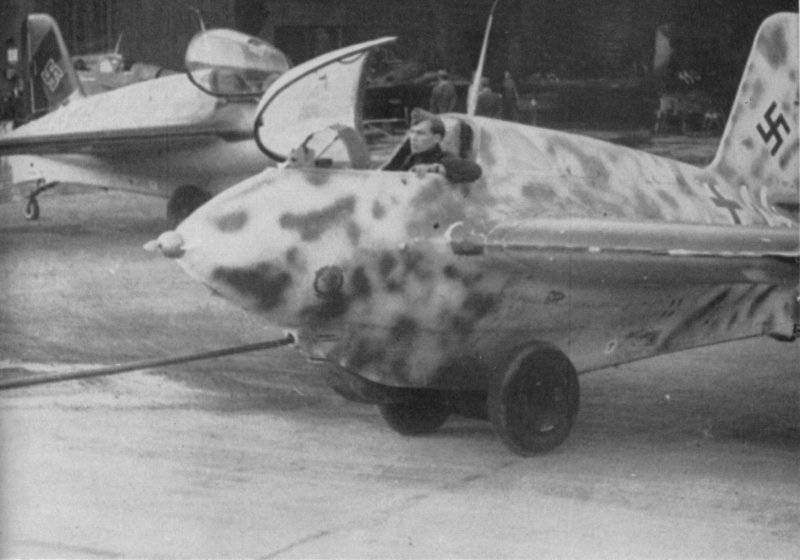
Very controversial system, very controversial. With an early dump, the truck could bounce off the runway and “catch up” with the plane, which once happened and caused the plane to crash. If the trolley was not reset, the pilot was ordered to leave the car, since landing on the trolley was impossible due to the lack of safety margin, and it was impossible to let out the ski, as the trolley locks did not allow it.
Cleaning and release of the ski and tail wheel provided a special pneumohydraulic system. Before each departure, special cylinders were charged with compressed air, the energy of which was transferred to hydraulic accumulators and then to hydraulic cylinders. Hydraulic cylinders in combination with hydraulic accumulators also served as shock absorbers.
Ski depreciation was insufficient, which caused injuries to pilots during landing. This caused the installation of shock absorbers on the pilot's seat. In addition, the procedure of lifting the aircraft, cleaning the skis and hoisting the trolley on its own was very cumbersome, but it served one thing: maximum relief of the aircraft.
It turned out to be easier, but the starting and after-flight procedures were more than a tedious task.
The radio equipment consisted of a FuG 16ZU radio station and the associated FuG 25a identification system. Blocks of equipment were located in the cockpit and in the front compartment, antennas - on the mast at the top of the fuselage and in the front edge of the keel (FuG 16ZU) and under the right wing (FuG 25a). Some aircraft were additionally equipped with a radio compass, but this was clearly an excess, since the Me.163 flew only during the day and at fairly short distances, so getting lost was unrealistic.
A few words about weapons. At first, the armament was completely insufficient, and the situation was not corrected by the replacement of guns.
Initially, in 1943, the armament consisted of two MG-151/20 cannons with a caliber of 20 mm, with a reserve of 100 shells per barrel. The guns were mounted in the root of the wing, the ammunition was placed on top of the oxidizer tank, that is, in the area of the center of gravity of the aircraft and did not affect the alignment of the machine as it was consumed.
However, the 20-mm shells, not to mention the 15-mm shells, did not have such damaging properties as we would like. Therefore, starting with the modification of Me.163V-1, they began to install the MK-108, which had a larger caliber (30 mm) with all the consequences.
But the MK-108 had another drawback: a short barrel, weak ballistics, low rate of fire and poor reliability. In the complex, the replacement did not give any advantages, because, approaching at such speeds, the Me.163 pilot managed to release only a few shells, which did not always ensure the proper defeat of the target.
An interesting attempt was made to strengthen weapons with the help of the SG500 "Jagerfaust" system. This is a 50 mm grenade developed on the basis of Panzerfaust in a tubular guide. A pack of five such launchers were installed VERTICALLY in the root of the wing, above the guns. The launch system was very interesting, it was assumed that the launch of grenades from an aircraft flying under the formation of bombers at a distance of up to 100 meters will be carried out automatically using a photocell as soon as the fighter’s shadow covers the target.
The system was first tested on the Fock Wulf FW.190, and after relatively successful results, the SG500 was installed on 12 aircraft. But nothing is known about the successful application and the victories won with the help of Jagerfaust.
In general, the exploitation of Me.163 resulted not only in "Pfennig", it smelled like a suitcase of real Deutschmarks, you know. Too many different equipment had to be designed in order to ensure flights of a machine that was not produced by the largest series. Less than 500 (472, including prototypes) is not very significant.
But for half a thousand aircraft, tractors, cranes, special refueling tanks for fuel and oxidizer were designed. Plus, a rather large number of qualified personnel was required, and not so much aviation as chemical.
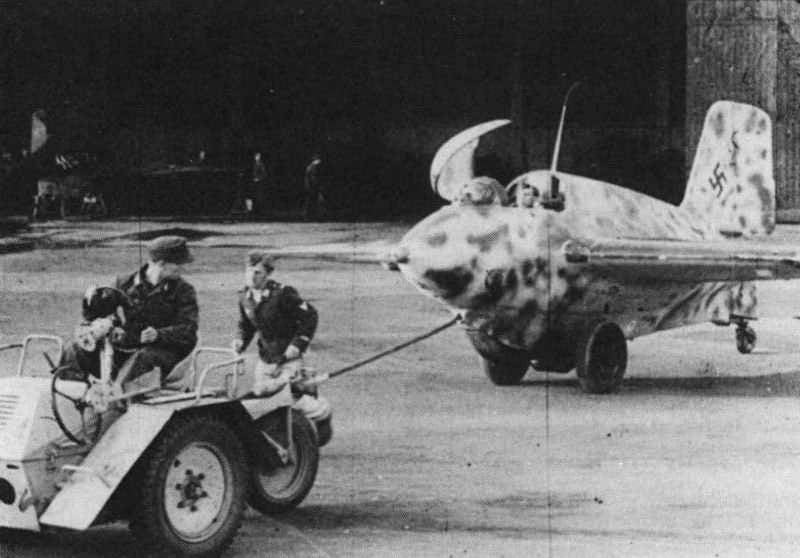
The fuel components were toxic, aggressive, and when combined with each other or with some materials (iron oxides, for example) exploded very willingly. Of course, there was one plus, all fuel components willingly interacted with water. And decomposed by it. Therefore, the most fun at the Me.163 airfields was the fire brigade, which constantly had to pour water over the river, flushing all devices, containers and filling valves. The tail of the fuselage, the combustion chamber and the engine assembly box were also washed. Concrete was also poured under the plane and refueling sites.
Nevertheless, the planes caught fire, exploded, technical personnel received burns and even fatalities.
In general, at the development stage, Me.163 posed a greater danger to the Germans than to the Allies. However, the huge amount of work and development that has been carried out subsequently made it possible to operate normally chemically more quiet aircraft with turbojet engines Me.262, He.162, Ar.234.
The flights on the Comet themselves were a very peculiar affair. Too short a flight time was allotted to take off, gain altitude, detect and attack the enemy, get away from possible pursuit and land the car at your airfield.
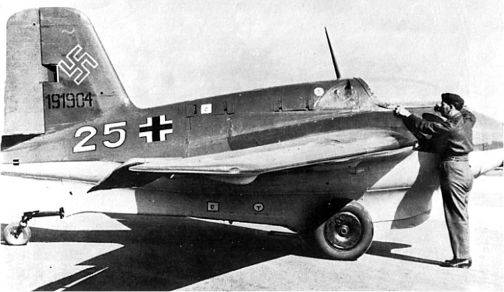
And here a dilemma arose: on the one hand, Me.163 was a completely new species weaponswhich needed to be mastered. And this required not just the time of the pilots, but the time of highly trained and experienced pilots. Which could be more useful in the cockpits of conventional fighters.
Recruiting pilots for training on Comet flights was preferred from gliders. The first unit (ЕКdo-16) was equipped with just such pilots, and Wolfgang Shpaate was appointed commander, and the world’s repeated world champion in glider flights.
Training in the combat training squadron began with glider training. First, several flights were performed on the Habicht glider. Moreover, these gliders had different wingspan: 13,6 m, 8 m or 6 m. Depending on the success, cadets were planted on one or another device, gradually reducing the wing area and increasing landing speed. For the “six-meter” glider, it was already 100 km / h. Then 6 flights were performed on an empty Me.163A, which had a landing speed of 150 km / h. The following planning was carried out from a height of 1500 m on Me.163A, filled with water. After the successful development of the landing, they embarked on missile flights.
First, two rocket-propelled take-offs were carried out, and then one flight at half-fueling. After that, the pilot changed to combat Me.163B and performed two flights on it with full refueling. After these flights, the pilot was considered ready for combat intercept flights. Training intercepts and aerial firing themselves were not foreseen by the plan. Such a short training cycle was explained by the lack of fuel, which was supposed to compensate for the combat experience of the cadets.
By September 1944, combat training (E.K.16) and two combat squadrons (1 / JG400 and 2 / JG400) were concentrated at the Brandis airfield, near Loin, near Leipzig. There were factories for the production of synthetic fuel, which were the object of close attention of the Allied bombing aircraft. It was there that the first combat use of Me.163V took place.
The application showed that in vain during the preparation process, due attention was not paid to the tactics and practice of shooting, because it turned out that speed can be not only an advantage, but also a disadvantage.
The rapprochement with the enemy was so rapid that the pilots simply did not have time to aim and open fire. Well, not the most rapid-fire guns MK-108. In total, pilots of squadrons on Me.163B shot down 9 enemy bombers, with the loss of 14 of their aircraft. Plus 11 aircraft were lost as a result of various flight and ground accidents not related to the enemy.
Different experts explain such low efficiency in different ways, but it seems to me that learning to shoot, getting used to a new plane during a sortie, is not the best way to learn. Even with combat experience, it is one thing to try to get out of the MK-108 at an approach speed of 800 km / h (500 of your own and 300 at the target), and quite another when the approach speed is over 1000 km / h.
It would be possible to artificially reduce the speed during an attack using, for example, air brakes, but again everything would rest on the fuel supply on the way back.
Major Shpaate, the commander of the first jet staffel, completed the first combat mission on May 14, 1944. It was generally the first combat mission of the Comet. Shpaate flew to intercept a pair of R-47 fighters flying in the vicinity of the Bad Zwischengen test center. But someone was unlucky: on Me.163, the engine stalled at the time of the attack.
It is unclear why the pilots of the Thunderbolts did not shoot the Comet Shpaate, especially since the plane was red and was clearly visible in the sky. Probably, they simply did not take seriously something small and bright in color.
Shpaate managed to start the engine and safely return to base. And in the early days of the service, there were a lot of unsuccessful sorties.
The first successful battle took place on August 16, 1944. Sausage from more than a thousand B-17 and B-24 bombers went on target in central Germany. Their path passed near Brandis, where the first staffel was based, at the disposal of which there were five interceptors ready for battle. All five aircraft were thrown into battle.
The first Me.163 was shot down by the arrows of one of the "fortresses", the pilot escaped by parachute.
The second interceptor was unsuccessfully fired by gunners, but it itself did not cause damage to the bombers.
The third Comet, Lieutenant Rull, successfully attacked and shot down the B-17G. This was the first victory of Me.163. True, it didn’t deliver laurels to Rullu very much because he ran out of fuel at the exit, the plane lost speed, he was caught by the Mustangs from escort and shot down.
The fourth and fifth Me.163 shot at someone, but did not hit. But at least they returned to base.
In general, the score of the first battle was 2: 1 in favor of the Allies.
In the future, the activity of "Comets" was dictated solely by the presence of fuel, with which the closer to the end of the war, the worse. The Allies methodically destroyed the entire infrastructure of Germany, and several dozen jet interceptors simply could not provide at least some resistance to hundreds of bombers.
Accordingly, the number of personnel was reduced, personnel were sent to the front, and at the time of surrender, there were about 80 operational Me.163 and 60 pilots in the squadrons.
The effectiveness of "Comets" really turned out to be insignificant. German sources say about 16 downed planes of allies of all models, allies recognize only 9.
Pilots of the USA and Britain say about six victories in the air over Me.163, side-shooters of bombers claim 22 shot down planes. But still, this does not compare with the amount of Me.163 that was lost in testing, training flights and flight accidents. The number of non-combat losses exceeded one hundred.
In general, the use of Me.163 cannot be considered satisfactory, even taking into account the novelty. The percentage of losses turned out to be too huge, especially the non-combat losses.
Did the plane have at least some future?
Well, the Messerschmitt believed that yes. And they worked on the third version of the interceptor, Me.163C. It was an aircraft with a newly designed fuselage, taking into account all the achievements of previous models.
The Me.163 had a longer fuselage, this made it possible to remove the tanks from the cockpit forever, increase the fuel supply and transfer guns from the wing to the fuselage. The chassis layout remains the same - take-off on a dump truck, and landing on a ski. Three prototypes were built.
In parallel with the Me.163C version, the Me.163D aircraft was designed, in which the shortcomings of previous models were almost completely eliminated. The aircraft had an “adult” three-wheeled landing gear with a nose wheel retracted into the fuselage. The cabin was airtight, for which air was compressed by a compressor driven by a nose propeller. The first Me.163D VI prototype was ready in the early summer of 1944.
Messerschmitt’s reluctance to continue work on it was ruined. Still, the company was very thoroughly loaded with orders, and there was simply no time and resources left for Comet. Therefore, Willy Messerschmitt simply “kicked off” the “Comet” to Junkers.
The first flights began without landing gear when RLM decided to transfer production to the Junkers factories. Prof. Messerschmitt was only happy with this decision, as his company was loaded with other projects.
At Junkers, the design work was headed by Professor Hertel, and the aircraft was designated Ju.248.
Alterations turned out to be minimal: the lantern became possible to reset with the help of squibs, instead of a nasal armored cone several armor plates were installed. The ammunition stock of the MK-108 guns was increased to 150 shells per barrel. The engine was the HWK 109-509C. They wanted to install a BMW 708 engine, which produced slightly more traction than Walter's product, but used nitric acid as an oxidizing agent. But it didn’t even reach the test, and the Red Army was the only prototype of the trophy.
If you evaluate the project not critically, then, of course, Comet has left a mark in the history of aviation. But this trace led to a dead end. Yes, the plane showed a number of outstanding indicators in terms of flight speed and climb, and the Comet came close to the sound barrier, but ...
But like a combat aircraft, a nitrogen-hydrogen-acid lighter was completely nonexistent. Yes, the work on liquid propellant rocket launchers, begun in attempts to make airplanes fly faster, succeeded and subsequently developed, but already in the field of rocketry. Including space.
But like planes, missile interceptors could not stand any competition with safer turbojet aircraft.
Why am I speaking in the plural? Well, because Me.163 had followers. This cannot be called competitors.
Firstly, the Soviet BI-1. Exactly the same plane as a matter of fact, but unlike the Germans, ours could not at the proper level realize the idea of a turbopump unit for supplying fuel. Yes, ours also realized that neither rotary nor piston pumps are suitable for supplying fuel to such voracious engines. But we have not yet been able to create a normal centrifugal pump.
Yes, BI-1 completely in accordance with the concept of application coincided with Me.163. Takeoff, fast climb, the only enemy bomber attack, return to the airfield.
On the whole, it was not such an advanced aircraft as the Me.163, but it is worth talking about BI-1 in a separate article.
The absence of TNA forced the use of a fuel displacement system, which made the power plant many times heavier. In this we are far behind the Germans. We decided to use nitric acid as an oxidizing agent, the liquid is aggressive and poisonous, but the fuel was safe - kerosene. In addition, this pair, unlike the German components, was not self-igniting. Clearly it was safer.
Yes, after the crash in the test flight, all the work on the BI-1 was curtailed, but I think, including because we did not need such an interceptor. If there really was a need for a missile fighter in the Red Army Air Force, for some reason there is absolutely no doubt that we would have such an aircraft.
The second analogue of Me.163B was the Japanese licensed copy of J8M1 "Shusui" - "The Punishing Sword". The Japanese received a set of technical documentation and one copy of Me.163B, which the Germans delivered to Japan in their submarines.
The Japanese immediately faced three problems: aircraft production, engine production and fuel production. It is simply amazing how, with a lack of information and in the conditions of constant bombing, Japanese engineers were able to solve them in about a year.
The “punishing sword”, quite naturally, differed from its prototype: Japanese guns were installed, which were longer and heavier than the German ones. The radio station was also replaced by a Japanese one. The glider was made all-metal (and this is due to a shortage of raw materials), although the frames of the elevons, trim tabs and the steering wheel remained wooden, with linen sheathing. They threw out some equipment and simplified some systems. As a result, the weight of an empty aircraft (1445 kg) was less than that of the prototype - 1505 kg.
Even the engine was able to assemble, debug and start. And the plane went on its first flight, but it turned out that the engine stalled at a low altitude. The plane crashed, the pilot died. On this, the program of the “Punishing Sword” was curtailed, because there was no time to punish.
Me.163 rival can be considered Ba.349A "Nutter" interceptor, which we already wrote about. It had smaller dimensions, consumed less fuel, but had the same radius of action due to vertical take-off and the absence of the need to return to its airfield. Disposable weapons, so to speak, so as not to offend much.
So the Comet became a kind of testing ground for rocketry and its infrastructure, which after the war was used by everyone who could reach it. And, I must say, the development of Walter and Lippis turned out to be very useful for many designers, however, somewhat in other areas.
But this is a completely different story.
LTX: Me.163B-1a.
Wingspan, m: 9,30.
Length, m: 5,80.
Height, m: 2,75.
Wing Area, m2: 18,75.
Weight, kg:
- empty aircraft: 1 900;
- normal takeoff: 4 300.
Engine: 1 x Walter HWK 509A-2 with a thrust of 1700 kgf.
Maximum speed km / h:
- near the ground: 825;
- at height: 955.
Maximum rate of climb, m / min: 4 800.
Practical ceiling, m: 12000.
Crew, person: 1.
Armament:
- two 20 mm MG.151 / 20 guns with 100 shells per barrel
or
- Two 30-mm MK.108 guns with 60 shells per barrel.
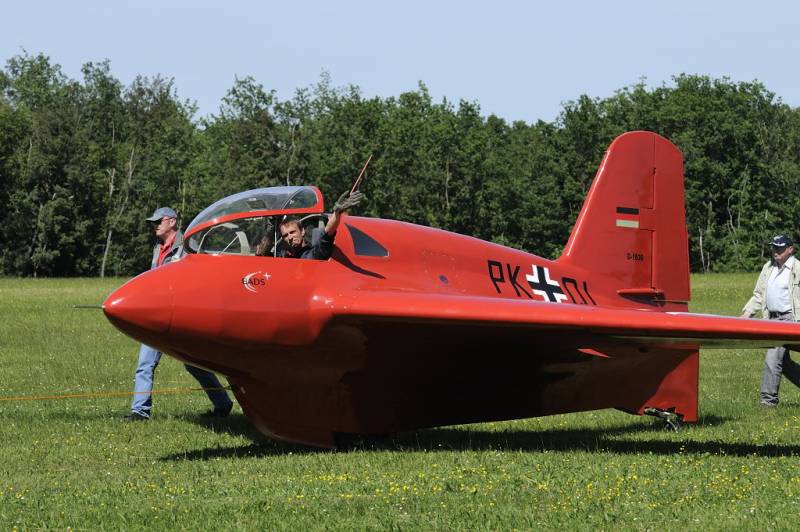
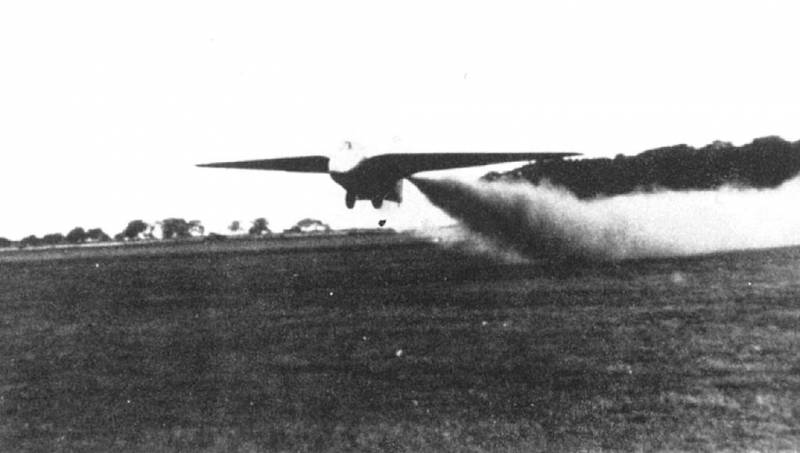
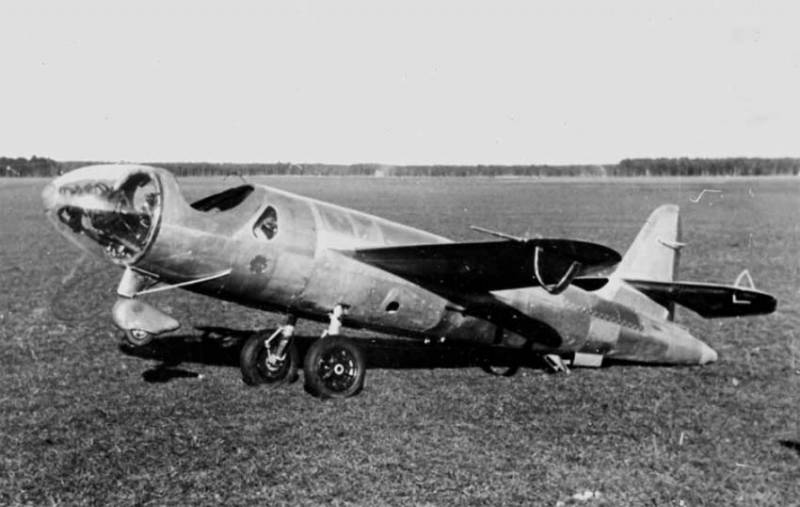
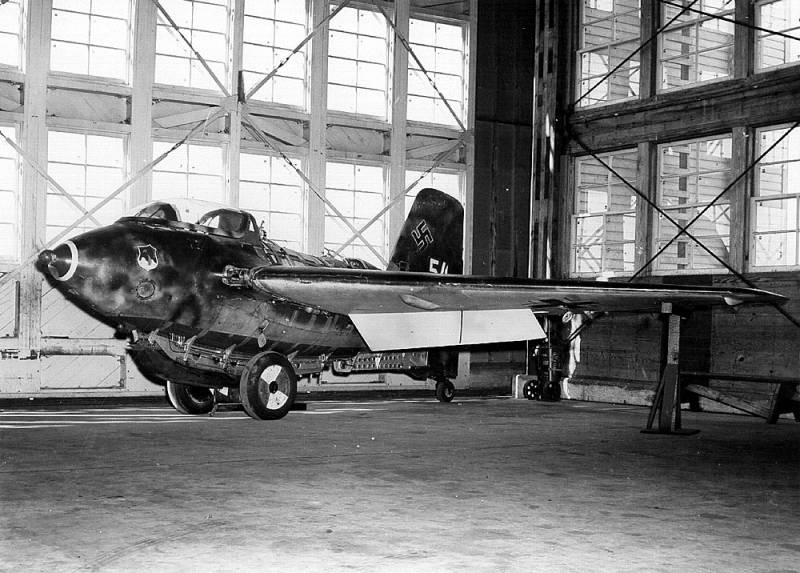
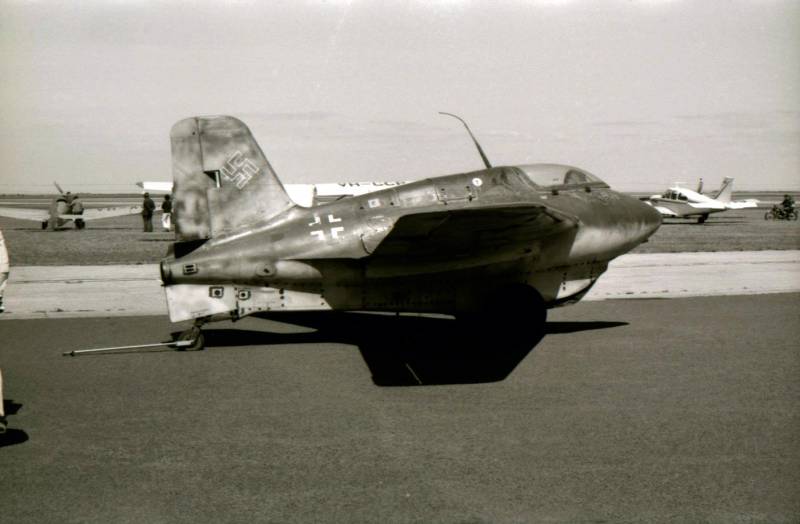
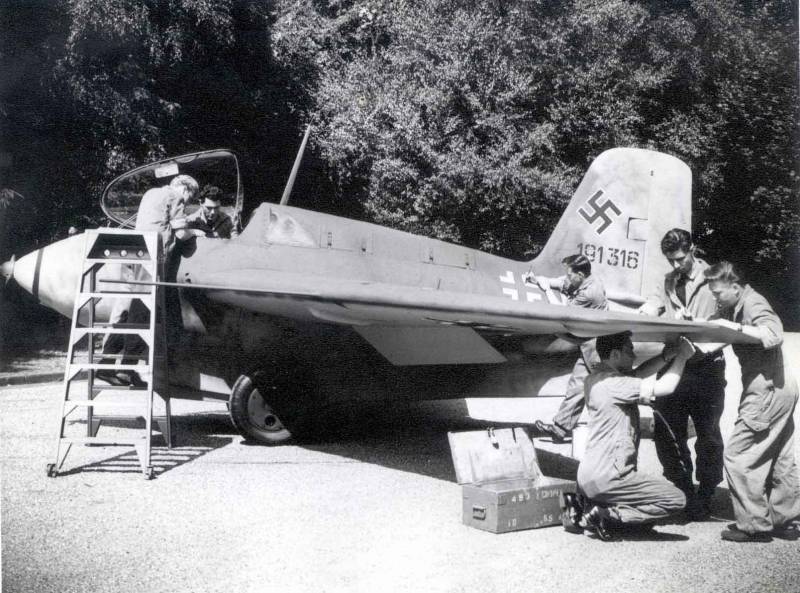
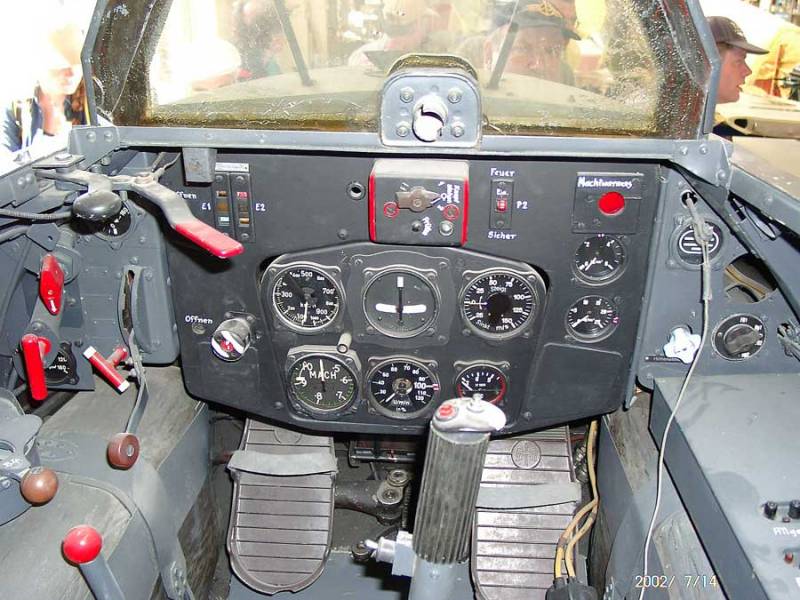
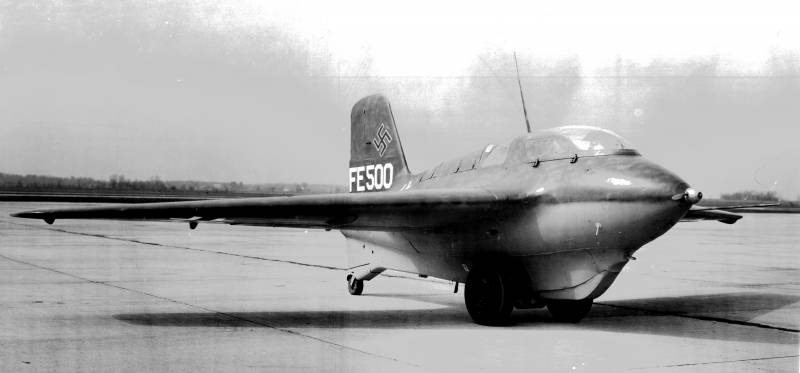
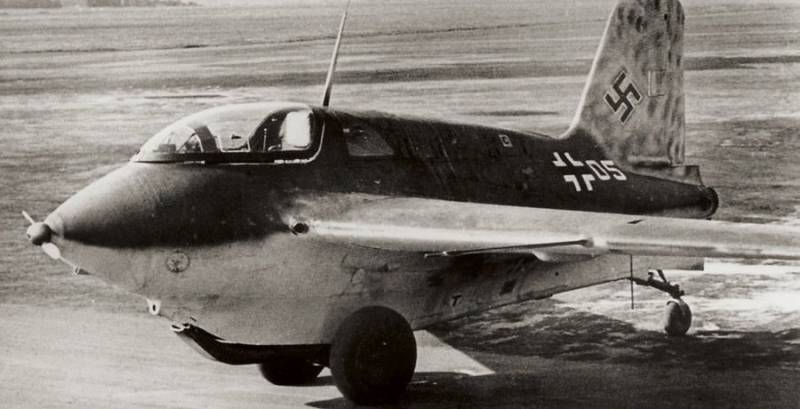
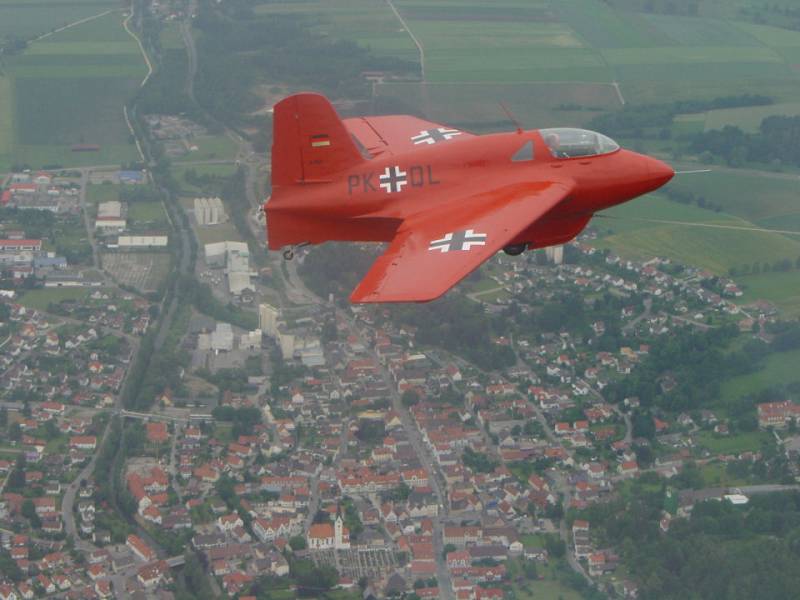
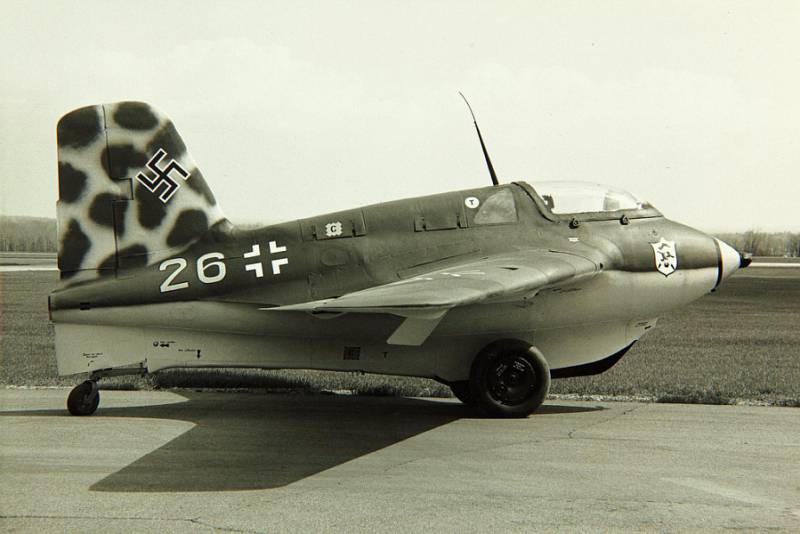

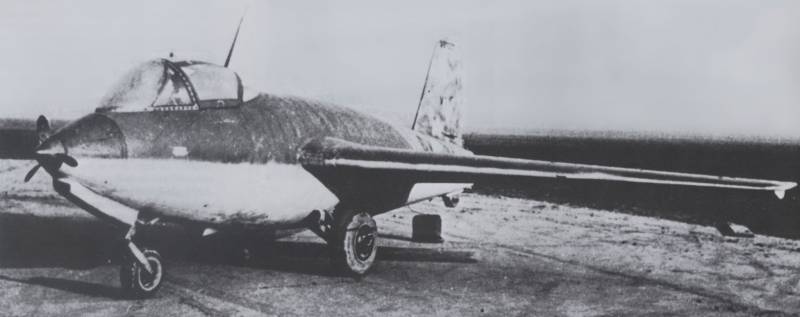
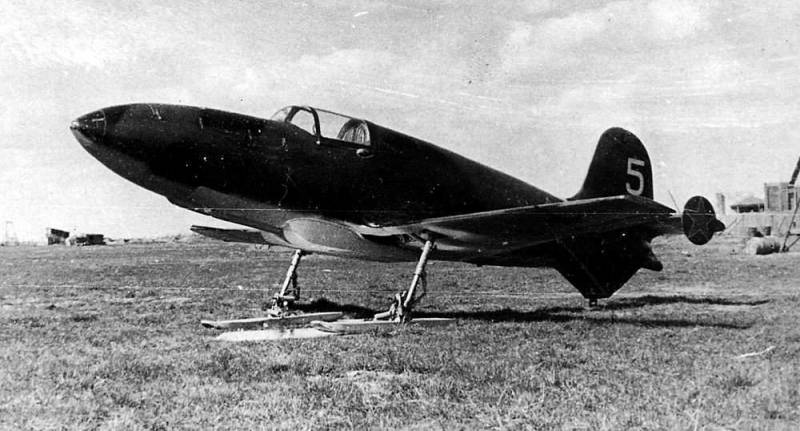
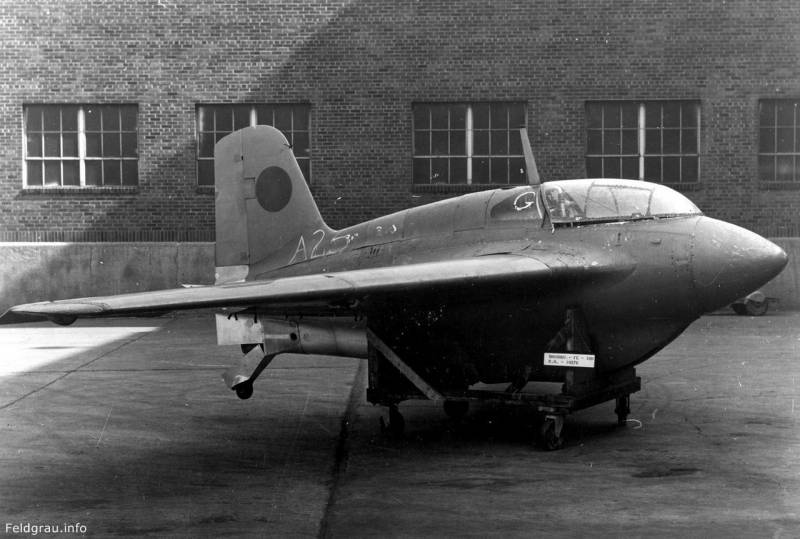
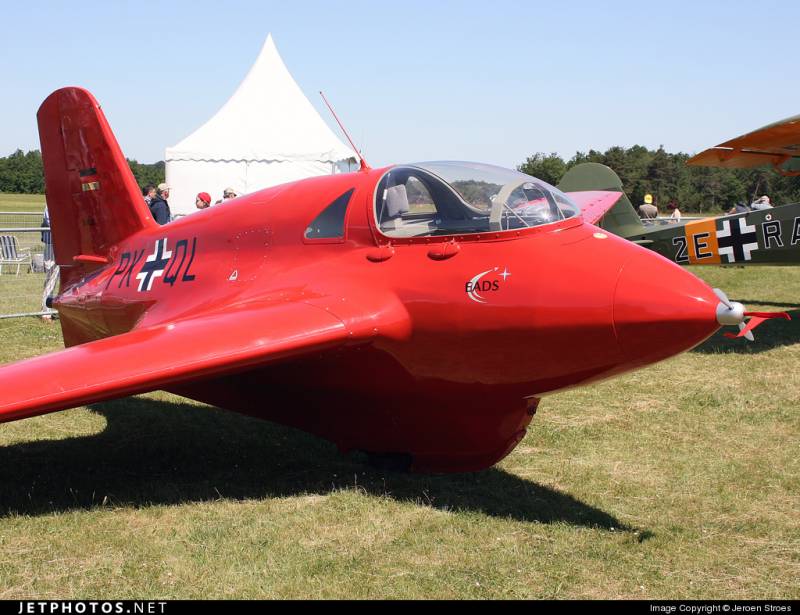
Information